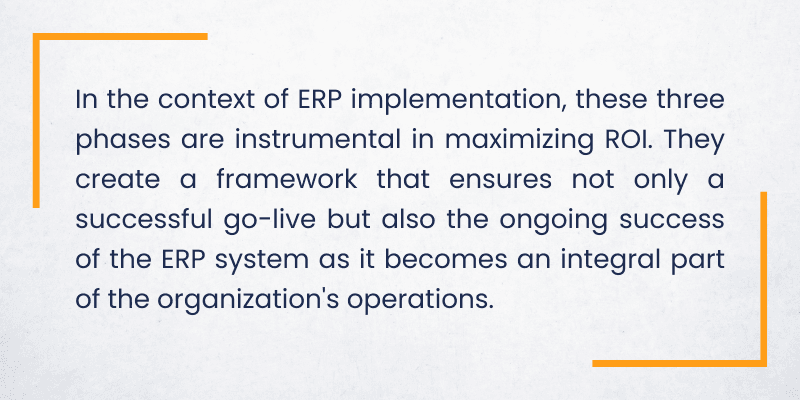

Change Management Blog
The Three Vital Phases of Change Management
July 17, 2023
Time to Read: 2 Min
The Three Vital Phases of Change Management
Change Management is a structured process that unfolds in three essential phases. These phases are pivotal in ensuring that organizational change, such as an ERP implementation, is not just initiated but embraced and sustained. Let's delve into each phase:
Phase 1: Preparing for the Change
Before embarking on any significant change initiative, it's imperative to lay a strong foundation. This phase involves meticulous planning and strategizing:
Understanding Impact: Gain a deep understanding of who within the organization will be impacted by the change and how it will affect them. Recognize that each individual may react differently to change, and their concerns should be addressed.
Change Management Assessment: Determine the extent of Change Management required based on the complexity of the change and its potential impact. Identify critical activities that will support a smooth transition.
Align key roles: By understanding and fulfilling their unique roles, all contributors create a collaborative environment that ensures the seamless integration of the change and drives the organization toward its desired outcomes.
Phase 2: Managing the Change
With a solid plan in place, it's time to put it into action. In this phase, the focus shifts to actively managing the change and preparing the workforce for new technologies and processes. Key activities include:
Managerial Coaching: Equip managers with the skills and guidance to become effective change leaders who can support and motivate their teams through the transition.
Stakeholder Engagement: Engage with stakeholders at all levels, identifying potential change champions who can help drive the transformation.
Effective Communication: Communicate key messages using various mediums to ensure that everyone in the organization is informed about the change, its purpose, and the benefits it will bring.
Employee Training: Provide the necessary training and resources to help employees acquire the skills and knowledge required to adapt to the change successfully.
Resistance Management: Proactively identify and address resistance to change. Understand that resistance is a natural part of the process and can be managed effectively with ADKAR®.
Phase 3: Sustaining the Change
One of the common pitfalls in Change Management is focusing solely on the initial phases and neglecting what comes afterward. The Sustainment Phase is critical step within the Change Management process steps to ensure that your organization reinforces the change moving forward to ensure that the organization continues to benefit:
Monitoring Progress: Use Key Performance Indicators (KPIs) to gauge buy-in and progress throughout the implementation and beyond. Continuously assess:
Are employees genuinely embracing the new way, or are they holding onto old habits?
Where are there gaps in knowledge and usability that need to be addressed?
What successes can be celebrated on both an individual and team basis?
This phase is about maintaining employee engagement and motivation long after the initial buy-in. It ensures that the organization not only adopts the change but also reaps the full benefits over time.

RelatedBlog Articles
The Critical Role of Sponsorship in Women Leadership
What CFOs Need to Know Before Selecting ERP Systems
9 Key Change Management Tips for Implementation Success



